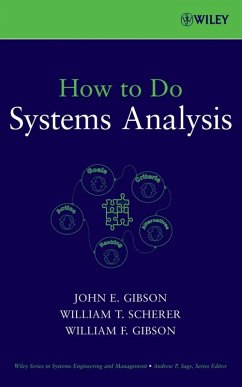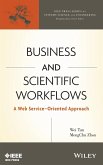- Gebundenes Buch
- Merkliste
- Auf die Merkliste
- Bewerten Bewerten
- Teilen
- Produkt teilen
- Produkterinnerung
- Produkterinnerung
Many systems engineering books describe the systematic process of developing, designing, and deploying large-scale complex systems, yet fail to present the fundamental systemic thinking needed to conceive complex systems and solve complex socio-technical problems. Rather than delve into the formal processes of systems engineering, this unique book emphasizes the underlying systems analysis component and associated though processes. Systems analysis focuses on problem definition and offers a unique book emphasizes the underlying systems analysis component and associated though processes.…mehr
Andere Kunden interessierten sich auch für
![Managing the Development of Software-Intensive Systems Managing the Development of Software-Intensive Systems]() James McDonaldManaging the Development of Software-Intensive Systems122,99 €
James McDonaldManaging the Development of Software-Intensive Systems122,99 €![Global Software and It Global Software and It]() Christof EbertGlobal Software and It81,99 €
Christof EbertGlobal Software and It81,99 €![Solving Enterprise Application Solving Enterprise Application]() Leonid GrinshpanSolving Enterprise Application98,99 €
Leonid GrinshpanSolving Enterprise Application98,99 €![Business and Scientific Workfl Business and Scientific Workfl]() Wei TanBusiness and Scientific Workfl158,99 €
Wei TanBusiness and Scientific Workfl158,99 €![System Engineering Analysis, Design, and Development System Engineering Analysis, Design, and Development]() Charles S. WassonSystem Engineering Analysis, Design, and Development144,99 €
Charles S. WassonSystem Engineering Analysis, Design, and Development144,99 €![Introduction to TTCN-3 Introduction to TTCN-3]() Colin WillcockIntroduction to TTCN-3118,99 €
Colin WillcockIntroduction to TTCN-3118,99 €![Emotion-Oriented Systems Emotion-Oriented Systems]() Catherine PelachaudEmotion-Oriented Systems227,99 €
Catherine PelachaudEmotion-Oriented Systems227,99 €-
-
-
Many systems engineering books describe the systematic process of developing, designing, and deploying large-scale complex systems, yet fail to present the fundamental systemic thinking needed to conceive complex systems and solve complex socio-technical problems. Rather than delve into the formal processes of systems engineering, this unique book emphasizes the underlying systems analysis component and associated though processes. Systems analysis focuses on problem definition and offers a unique book emphasizes the underlying systems analysis component and associated though processes. Systems analysis focuses on problem defining and offers a unique perspective on problem solving in all type so f domains. How to Do systems Analysis describes an approach that is appropriate for large-scale, complex systems in diverse disciplines. More specifically, How to Do Systems Analysis:
_ Covers the six major phases of systems analysis, including goal development, the index of performance, and alternative candidate solutions, as well as the management of the systems team, project management, and more
_ presents the core concepts of a general systems analysis methodology
_ Includes examples that illustrate systems analysis concepts, along with case studies of systems analysis and systems engineering in the real world
_ Features exercises at the end of many chapters to challenge readers to practice systems analysis thinking and skills
An eye-opening, thought-provoking reference for professionals in field that need input from systems engineering, such as telecommunications, transportation,m business consulting, and health care, this book is also a stimulating text for senior undergraduate and graduate students in systems engineering and systems analysis courses.
Hinweis: Dieser Artikel kann nur an eine deutsche Lieferadresse ausgeliefert werden.
_ Covers the six major phases of systems analysis, including goal development, the index of performance, and alternative candidate solutions, as well as the management of the systems team, project management, and more
_ presents the core concepts of a general systems analysis methodology
_ Includes examples that illustrate systems analysis concepts, along with case studies of systems analysis and systems engineering in the real world
_ Features exercises at the end of many chapters to challenge readers to practice systems analysis thinking and skills
An eye-opening, thought-provoking reference for professionals in field that need input from systems engineering, such as telecommunications, transportation,m business consulting, and health care, this book is also a stimulating text for senior undergraduate and graduate students in systems engineering and systems analysis courses.
Hinweis: Dieser Artikel kann nur an eine deutsche Lieferadresse ausgeliefert werden.
Produktdetails
- Produktdetails
- Wiley Series in Systems Engineering and Management 1
- Verlag: Wiley & Sons
- 1. Auflage
- Seitenzahl: 368
- Erscheinungstermin: 1. Mai 2007
- Englisch
- Abmessung: 248mm x 164mm x 28mm
- Gewicht: 635g
- ISBN-13: 9780470007655
- ISBN-10: 0470007656
- Artikelnr.: 22581372
- Herstellerkennzeichnung
- Libri GmbH
- Europaallee 1
- 36244 Bad Hersfeld
- gpsr@libri.de
- Wiley Series in Systems Engineering and Management 1
- Verlag: Wiley & Sons
- 1. Auflage
- Seitenzahl: 368
- Erscheinungstermin: 1. Mai 2007
- Englisch
- Abmessung: 248mm x 164mm x 28mm
- Gewicht: 635g
- ISBN-13: 9780470007655
- ISBN-10: 0470007656
- Artikelnr.: 22581372
- Herstellerkennzeichnung
- Libri GmbH
- Europaallee 1
- 36244 Bad Hersfeld
- gpsr@libri.de
John E. Gibson, PhD, was the Commonwealth Distinguished Professor of Systems Management at the School of Engineering and Applied Science, University of Virginia, Charlottesville. He was the past dean of engineering at two universities: The University of Virginia and Oakland University. His research was in manufactruring strategy and management and in total quality leadership. Dr. Gibson received his PhD from Yale University. William T. Scherer, PhD, is Professor in the Department of Systems and Information Engineering at the University of Virginia where he teaches courses on systems engineering. He has authored and co-authored numerous publications on intelligent decision support systems, combinatorial optimization, and stochastic control. He is an associate editor for International Abstracts in Operations Research and reviewer for Operations Research, Annals of Operations Research, and IEEE Trans-actions on Intelligent Transportation Systems (ITS). He has held the Lucien Carr III Professorship of Engineering, recognition of his excellence in undergraduate education.
Preface xi
A Personal Note from William T. Scherer xv
A Personal Note from William F. Gibson xvii
A Personal Note from Scott F. Ferber xix
Original Preface from Jack Gibson xxi
Acknowledgments xxiii
1 Introduction 1
1.1 What Is a System? 2
1.2 Terminology Confusion 4
1.3 Systems Analysis Equals Operations Research Plus Policy Analysis 6
1.4 Attributes of Large-Scale Systems 7
1.5 Intelligent Transportation Systems (ITS): An Example of a Large-Scale
System 8
1.6 Systems Integration 11
1.7 What Makes a "Systems Analysis" Different? 12
1.8 Distant Roots of Systems Analysis 14
1.9 Immediate Precursors to Systems Analysis 15
1.10 Development of Systems Analysis As a Distinct Discipline: The
Influence of RAND 17
Historical Case Study: IIASA (A) 20
Exercises 24
Case Study: Fun at Six Flags? 25
Historical Case Study: IIASA (B) 26
2 Six Major Phases of Systems Analysis 29
2.1 The Systems Analysis Method: Six Major Phases 29
2.2 The Goal-centered or Top-Down Approach 35
2.3 The Index of Performance Concept 40
2.4 Developing Alternative Scenarios 44
2.5 Ranking Alternatives 45
2.6 Iteration and the "Error-embracing" Approach 46
2.7 The Action Phase: The Life Cycle of a System 48
Exercises 50
Case Study: Methodologies or Chaos? Part A 51
Case Study: Methodologies or Chaos? Part B 52
Case Study: Wal-Mart Crisis! 53
3 Goal Development 55
3.1 Seven Steps in Goal Development 55
3.2 On Generalizing the Question 59
3.3 The Descriptive Scenario 61
3.4 The Normative Scenario 62
3.5 The Axiological Component 63
3.6 Developing an Objectives Tree 66
3.7 Fitch's Goals for an Urbanizing America: An Example of Objectives Tree
Construction 73
3.8 Content Analysis of Fitch's Goals 79
3.9 Validate 82
3.10 Iterate 83
Case Study: Distance Learning in the Future? 84
Historical Case Study: Goals of 4C, Inc. 85
4 The Index of Performance 89
4.1 Introduction 89
4.2 Desirable Characteristics for an Index of Performance 91
4.3 Economic Criteria 95
4.4 Compound Interest 96
4.5 Four Common Criteria of Economic Efficiency 98
4.6 Is There a Problem with Multiple Criteria? 100
4.7 What Is Wrong with the B-C Ratio? 105
4.8 Can IRR Be Fixed? 107
4.9 Expected Monetary Value 109
4.10 Nonmonetary Performance Indices 111
Exercises 114
Case Study: Sky High Airlines 116
Case Study: Bridges-Where to Spend the Security Dollars? 122
Case Study: Measuring the Process and Outcomes of Regional Transportation
Collaboration 122
Case Study: Baseball Free Agent Draft 123
5 Develop Alternative Candidate Solutions 129
5.1 Introduction 129
5.2 The Classical Approach to Creativity 129
5.3 Concepts in Creativity 131
5.4 Brainstorming 132
5.5 Brainwriting 135
5.6 Dynamic Confrontation 137
5.7 Zwicky's Morphological Box 137
5.8 The Options Field/Options Profile Approach 139
5.9 Computer Creativity 143
5.10 Computer Simulation: a Tool in Option Development 144
5.11 Why a Dynamic Simulation for Creating Options? 145
5.12 Context-Free Simulation Models? 147
5.13 Bottom-Up Simulation or Top-Down? 148
5.14 Lessons from the Susquehanna River Basin Model 151
5.15 The Forrester Urban Model (FUM) and Societal Values 153
5.16 Extensions and Variations 157
5.17 Where to go from Here? 159
Exercises 159
Case Study: Winnebago 160
Case Study: Distance Learning in the Future? 160
Historical Case Study: Real-Time Television Link with Mars Orbiter 160
Historical Case Study: A Highway Vehicle Simulator RFP From DOT 180
6 Rank Alternative Candidates 185
6.1 Introduction 185
6.2 Rating and Ranking Methods 186
6.3 Condorcet and Arrow Voting Paradoxes 188
6.4 A MultiStage Rating Process 192
6.5 Decision Analysis 197
6.6 Basic Axioms of Decision Theory 199
6.7 Properties of Utility Functions 203
6.8 Constructing a Utility Curve 205
6.9 Some Decision Analysis Classic Examples 207
6.10 Estimation Theory in Decision Analysis 213
6.11 Some Practical Problems with Decision Analysis 221
6.12 Practical Trade Studies 224
Exercises 231
Case Study: Training Center Location 234
Case Study: Corporate Headquarters Location 235
Case Study: Business School Selection 236
7 Iteration and Transition 239
7.1 Iteration 239
7.2 Segment and Focus 241
7.3 The Transition Scenario 241
7.4 The Gantt Chart 242
7.5 Interaction Matrices 243
7.6 The Delta Chart 248
7.7 The Audit Trail 250
7.8 Cost of Failure to Stay on Schedule 252
7.9 Responsibilities of Major Actors 253
7.10 Sign-Offs by Cooperating Groups 253
Exercises 254
8 Management of the Systems Team 257
8.1 Introduction 257
8.2 Personal Style in an Interdisciplinary Team 257
8.3 "Out-Scoping" and "In-Scoping" in a System Study 260
8.4 Building the Systems Team 261
8.5 Tips on Managing the Team 263
8.6 Functional or Project Management? 264
8.7 How to Make an Effective Oral Presentation 266
8.8 How to Write a Report 273
9 Project Management 277
9.1 Introduction 277
9.2 Project Management Versus Process Management 279
9.3 The Hersey-Blanchard Four-Mode Theory 281
9.4 Relation of Management Style to Project Management 285
9.5 Preliminary Project Planning 286
9.6 Dealing with Conflict in Project Management 287
9.7 Life-Cycle Planning and Design 288
9.8 PERT/CPM Program Planning Method: An Example 292
9.9 Quality Control in Systems Projects 297
Case Study: Project Management 298
10 The 10 Golden Rules of Systems Analysis 301
10.1 Introduction 301
10.2 Rule 1: There Always Is a Client 302
10.3 Rule 2: Your Client Does Not Understand His Own Problem 303
10.4 Rule 3: The Original Problem Statement is too Specific: You Must
Generalize the Problem to Give it Contextual Integrity 304
10.5 Rule 4: The Client Does Not Understand the Concept of the Index of
Performance 306
10.6 Rule 5: You are the Analyst, Not the Decision-Maker 309
10.7 Rule 6: Meet the Time Deadline and the Cost Budget 310
10.8 Rule 7: Take a Goal-Centered Approach to the Problem, Not a
Technology-Centered or Chronological Approach 311
10.9 Rule 8: Nonusers Must be Considered in the Analysis and in the Final
Recommendations 312
10.10 Rule 9: The Universal Computer Model is a Fantasy 314
10.11 Rule 10: The Role of Decision-Maker in Public Systems is Often a
Confused One 314
References 319
Index 331
A Personal Note from William T. Scherer xv
A Personal Note from William F. Gibson xvii
A Personal Note from Scott F. Ferber xix
Original Preface from Jack Gibson xxi
Acknowledgments xxiii
1 Introduction 1
1.1 What Is a System? 2
1.2 Terminology Confusion 4
1.3 Systems Analysis Equals Operations Research Plus Policy Analysis 6
1.4 Attributes of Large-Scale Systems 7
1.5 Intelligent Transportation Systems (ITS): An Example of a Large-Scale
System 8
1.6 Systems Integration 11
1.7 What Makes a "Systems Analysis" Different? 12
1.8 Distant Roots of Systems Analysis 14
1.9 Immediate Precursors to Systems Analysis 15
1.10 Development of Systems Analysis As a Distinct Discipline: The
Influence of RAND 17
Historical Case Study: IIASA (A) 20
Exercises 24
Case Study: Fun at Six Flags? 25
Historical Case Study: IIASA (B) 26
2 Six Major Phases of Systems Analysis 29
2.1 The Systems Analysis Method: Six Major Phases 29
2.2 The Goal-centered or Top-Down Approach 35
2.3 The Index of Performance Concept 40
2.4 Developing Alternative Scenarios 44
2.5 Ranking Alternatives 45
2.6 Iteration and the "Error-embracing" Approach 46
2.7 The Action Phase: The Life Cycle of a System 48
Exercises 50
Case Study: Methodologies or Chaos? Part A 51
Case Study: Methodologies or Chaos? Part B 52
Case Study: Wal-Mart Crisis! 53
3 Goal Development 55
3.1 Seven Steps in Goal Development 55
3.2 On Generalizing the Question 59
3.3 The Descriptive Scenario 61
3.4 The Normative Scenario 62
3.5 The Axiological Component 63
3.6 Developing an Objectives Tree 66
3.7 Fitch's Goals for an Urbanizing America: An Example of Objectives Tree
Construction 73
3.8 Content Analysis of Fitch's Goals 79
3.9 Validate 82
3.10 Iterate 83
Case Study: Distance Learning in the Future? 84
Historical Case Study: Goals of 4C, Inc. 85
4 The Index of Performance 89
4.1 Introduction 89
4.2 Desirable Characteristics for an Index of Performance 91
4.3 Economic Criteria 95
4.4 Compound Interest 96
4.5 Four Common Criteria of Economic Efficiency 98
4.6 Is There a Problem with Multiple Criteria? 100
4.7 What Is Wrong with the B-C Ratio? 105
4.8 Can IRR Be Fixed? 107
4.9 Expected Monetary Value 109
4.10 Nonmonetary Performance Indices 111
Exercises 114
Case Study: Sky High Airlines 116
Case Study: Bridges-Where to Spend the Security Dollars? 122
Case Study: Measuring the Process and Outcomes of Regional Transportation
Collaboration 122
Case Study: Baseball Free Agent Draft 123
5 Develop Alternative Candidate Solutions 129
5.1 Introduction 129
5.2 The Classical Approach to Creativity 129
5.3 Concepts in Creativity 131
5.4 Brainstorming 132
5.5 Brainwriting 135
5.6 Dynamic Confrontation 137
5.7 Zwicky's Morphological Box 137
5.8 The Options Field/Options Profile Approach 139
5.9 Computer Creativity 143
5.10 Computer Simulation: a Tool in Option Development 144
5.11 Why a Dynamic Simulation for Creating Options? 145
5.12 Context-Free Simulation Models? 147
5.13 Bottom-Up Simulation or Top-Down? 148
5.14 Lessons from the Susquehanna River Basin Model 151
5.15 The Forrester Urban Model (FUM) and Societal Values 153
5.16 Extensions and Variations 157
5.17 Where to go from Here? 159
Exercises 159
Case Study: Winnebago 160
Case Study: Distance Learning in the Future? 160
Historical Case Study: Real-Time Television Link with Mars Orbiter 160
Historical Case Study: A Highway Vehicle Simulator RFP From DOT 180
6 Rank Alternative Candidates 185
6.1 Introduction 185
6.2 Rating and Ranking Methods 186
6.3 Condorcet and Arrow Voting Paradoxes 188
6.4 A MultiStage Rating Process 192
6.5 Decision Analysis 197
6.6 Basic Axioms of Decision Theory 199
6.7 Properties of Utility Functions 203
6.8 Constructing a Utility Curve 205
6.9 Some Decision Analysis Classic Examples 207
6.10 Estimation Theory in Decision Analysis 213
6.11 Some Practical Problems with Decision Analysis 221
6.12 Practical Trade Studies 224
Exercises 231
Case Study: Training Center Location 234
Case Study: Corporate Headquarters Location 235
Case Study: Business School Selection 236
7 Iteration and Transition 239
7.1 Iteration 239
7.2 Segment and Focus 241
7.3 The Transition Scenario 241
7.4 The Gantt Chart 242
7.5 Interaction Matrices 243
7.6 The Delta Chart 248
7.7 The Audit Trail 250
7.8 Cost of Failure to Stay on Schedule 252
7.9 Responsibilities of Major Actors 253
7.10 Sign-Offs by Cooperating Groups 253
Exercises 254
8 Management of the Systems Team 257
8.1 Introduction 257
8.2 Personal Style in an Interdisciplinary Team 257
8.3 "Out-Scoping" and "In-Scoping" in a System Study 260
8.4 Building the Systems Team 261
8.5 Tips on Managing the Team 263
8.6 Functional or Project Management? 264
8.7 How to Make an Effective Oral Presentation 266
8.8 How to Write a Report 273
9 Project Management 277
9.1 Introduction 277
9.2 Project Management Versus Process Management 279
9.3 The Hersey-Blanchard Four-Mode Theory 281
9.4 Relation of Management Style to Project Management 285
9.5 Preliminary Project Planning 286
9.6 Dealing with Conflict in Project Management 287
9.7 Life-Cycle Planning and Design 288
9.8 PERT/CPM Program Planning Method: An Example 292
9.9 Quality Control in Systems Projects 297
Case Study: Project Management 298
10 The 10 Golden Rules of Systems Analysis 301
10.1 Introduction 301
10.2 Rule 1: There Always Is a Client 302
10.3 Rule 2: Your Client Does Not Understand His Own Problem 303
10.4 Rule 3: The Original Problem Statement is too Specific: You Must
Generalize the Problem to Give it Contextual Integrity 304
10.5 Rule 4: The Client Does Not Understand the Concept of the Index of
Performance 306
10.6 Rule 5: You are the Analyst, Not the Decision-Maker 309
10.7 Rule 6: Meet the Time Deadline and the Cost Budget 310
10.8 Rule 7: Take a Goal-Centered Approach to the Problem, Not a
Technology-Centered or Chronological Approach 311
10.9 Rule 8: Nonusers Must be Considered in the Analysis and in the Final
Recommendations 312
10.10 Rule 9: The Universal Computer Model is a Fantasy 314
10.11 Rule 10: The Role of Decision-Maker in Public Systems is Often a
Confused One 314
References 319
Index 331
Preface xi
A Personal Note from William T. Scherer xv
A Personal Note from William F. Gibson xvii
A Personal Note from Scott F. Ferber xix
Original Preface from Jack Gibson xxi
Acknowledgments xxiii
1 Introduction 1
1.1 What Is a System? 2
1.2 Terminology Confusion 4
1.3 Systems Analysis Equals Operations Research Plus Policy Analysis 6
1.4 Attributes of Large-Scale Systems 7
1.5 Intelligent Transportation Systems (ITS): An Example of a Large-Scale
System 8
1.6 Systems Integration 11
1.7 What Makes a "Systems Analysis" Different? 12
1.8 Distant Roots of Systems Analysis 14
1.9 Immediate Precursors to Systems Analysis 15
1.10 Development of Systems Analysis As a Distinct Discipline: The
Influence of RAND 17
Historical Case Study: IIASA (A) 20
Exercises 24
Case Study: Fun at Six Flags? 25
Historical Case Study: IIASA (B) 26
2 Six Major Phases of Systems Analysis 29
2.1 The Systems Analysis Method: Six Major Phases 29
2.2 The Goal-centered or Top-Down Approach 35
2.3 The Index of Performance Concept 40
2.4 Developing Alternative Scenarios 44
2.5 Ranking Alternatives 45
2.6 Iteration and the "Error-embracing" Approach 46
2.7 The Action Phase: The Life Cycle of a System 48
Exercises 50
Case Study: Methodologies or Chaos? Part A 51
Case Study: Methodologies or Chaos? Part B 52
Case Study: Wal-Mart Crisis! 53
3 Goal Development 55
3.1 Seven Steps in Goal Development 55
3.2 On Generalizing the Question 59
3.3 The Descriptive Scenario 61
3.4 The Normative Scenario 62
3.5 The Axiological Component 63
3.6 Developing an Objectives Tree 66
3.7 Fitch's Goals for an Urbanizing America: An Example of Objectives Tree
Construction 73
3.8 Content Analysis of Fitch's Goals 79
3.9 Validate 82
3.10 Iterate 83
Case Study: Distance Learning in the Future? 84
Historical Case Study: Goals of 4C, Inc. 85
4 The Index of Performance 89
4.1 Introduction 89
4.2 Desirable Characteristics for an Index of Performance 91
4.3 Economic Criteria 95
4.4 Compound Interest 96
4.5 Four Common Criteria of Economic Efficiency 98
4.6 Is There a Problem with Multiple Criteria? 100
4.7 What Is Wrong with the B-C Ratio? 105
4.8 Can IRR Be Fixed? 107
4.9 Expected Monetary Value 109
4.10 Nonmonetary Performance Indices 111
Exercises 114
Case Study: Sky High Airlines 116
Case Study: Bridges-Where to Spend the Security Dollars? 122
Case Study: Measuring the Process and Outcomes of Regional Transportation
Collaboration 122
Case Study: Baseball Free Agent Draft 123
5 Develop Alternative Candidate Solutions 129
5.1 Introduction 129
5.2 The Classical Approach to Creativity 129
5.3 Concepts in Creativity 131
5.4 Brainstorming 132
5.5 Brainwriting 135
5.6 Dynamic Confrontation 137
5.7 Zwicky's Morphological Box 137
5.8 The Options Field/Options Profile Approach 139
5.9 Computer Creativity 143
5.10 Computer Simulation: a Tool in Option Development 144
5.11 Why a Dynamic Simulation for Creating Options? 145
5.12 Context-Free Simulation Models? 147
5.13 Bottom-Up Simulation or Top-Down? 148
5.14 Lessons from the Susquehanna River Basin Model 151
5.15 The Forrester Urban Model (FUM) and Societal Values 153
5.16 Extensions and Variations 157
5.17 Where to go from Here? 159
Exercises 159
Case Study: Winnebago 160
Case Study: Distance Learning in the Future? 160
Historical Case Study: Real-Time Television Link with Mars Orbiter 160
Historical Case Study: A Highway Vehicle Simulator RFP From DOT 180
6 Rank Alternative Candidates 185
6.1 Introduction 185
6.2 Rating and Ranking Methods 186
6.3 Condorcet and Arrow Voting Paradoxes 188
6.4 A MultiStage Rating Process 192
6.5 Decision Analysis 197
6.6 Basic Axioms of Decision Theory 199
6.7 Properties of Utility Functions 203
6.8 Constructing a Utility Curve 205
6.9 Some Decision Analysis Classic Examples 207
6.10 Estimation Theory in Decision Analysis 213
6.11 Some Practical Problems with Decision Analysis 221
6.12 Practical Trade Studies 224
Exercises 231
Case Study: Training Center Location 234
Case Study: Corporate Headquarters Location 235
Case Study: Business School Selection 236
7 Iteration and Transition 239
7.1 Iteration 239
7.2 Segment and Focus 241
7.3 The Transition Scenario 241
7.4 The Gantt Chart 242
7.5 Interaction Matrices 243
7.6 The Delta Chart 248
7.7 The Audit Trail 250
7.8 Cost of Failure to Stay on Schedule 252
7.9 Responsibilities of Major Actors 253
7.10 Sign-Offs by Cooperating Groups 253
Exercises 254
8 Management of the Systems Team 257
8.1 Introduction 257
8.2 Personal Style in an Interdisciplinary Team 257
8.3 "Out-Scoping" and "In-Scoping" in a System Study 260
8.4 Building the Systems Team 261
8.5 Tips on Managing the Team 263
8.6 Functional or Project Management? 264
8.7 How to Make an Effective Oral Presentation 266
8.8 How to Write a Report 273
9 Project Management 277
9.1 Introduction 277
9.2 Project Management Versus Process Management 279
9.3 The Hersey-Blanchard Four-Mode Theory 281
9.4 Relation of Management Style to Project Management 285
9.5 Preliminary Project Planning 286
9.6 Dealing with Conflict in Project Management 287
9.7 Life-Cycle Planning and Design 288
9.8 PERT/CPM Program Planning Method: An Example 292
9.9 Quality Control in Systems Projects 297
Case Study: Project Management 298
10 The 10 Golden Rules of Systems Analysis 301
10.1 Introduction 301
10.2 Rule 1: There Always Is a Client 302
10.3 Rule 2: Your Client Does Not Understand His Own Problem 303
10.4 Rule 3: The Original Problem Statement is too Specific: You Must
Generalize the Problem to Give it Contextual Integrity 304
10.5 Rule 4: The Client Does Not Understand the Concept of the Index of
Performance 306
10.6 Rule 5: You are the Analyst, Not the Decision-Maker 309
10.7 Rule 6: Meet the Time Deadline and the Cost Budget 310
10.8 Rule 7: Take a Goal-Centered Approach to the Problem, Not a
Technology-Centered or Chronological Approach 311
10.9 Rule 8: Nonusers Must be Considered in the Analysis and in the Final
Recommendations 312
10.10 Rule 9: The Universal Computer Model is a Fantasy 314
10.11 Rule 10: The Role of Decision-Maker in Public Systems is Often a
Confused One 314
References 319
Index 331
A Personal Note from William T. Scherer xv
A Personal Note from William F. Gibson xvii
A Personal Note from Scott F. Ferber xix
Original Preface from Jack Gibson xxi
Acknowledgments xxiii
1 Introduction 1
1.1 What Is a System? 2
1.2 Terminology Confusion 4
1.3 Systems Analysis Equals Operations Research Plus Policy Analysis 6
1.4 Attributes of Large-Scale Systems 7
1.5 Intelligent Transportation Systems (ITS): An Example of a Large-Scale
System 8
1.6 Systems Integration 11
1.7 What Makes a "Systems Analysis" Different? 12
1.8 Distant Roots of Systems Analysis 14
1.9 Immediate Precursors to Systems Analysis 15
1.10 Development of Systems Analysis As a Distinct Discipline: The
Influence of RAND 17
Historical Case Study: IIASA (A) 20
Exercises 24
Case Study: Fun at Six Flags? 25
Historical Case Study: IIASA (B) 26
2 Six Major Phases of Systems Analysis 29
2.1 The Systems Analysis Method: Six Major Phases 29
2.2 The Goal-centered or Top-Down Approach 35
2.3 The Index of Performance Concept 40
2.4 Developing Alternative Scenarios 44
2.5 Ranking Alternatives 45
2.6 Iteration and the "Error-embracing" Approach 46
2.7 The Action Phase: The Life Cycle of a System 48
Exercises 50
Case Study: Methodologies or Chaos? Part A 51
Case Study: Methodologies or Chaos? Part B 52
Case Study: Wal-Mart Crisis! 53
3 Goal Development 55
3.1 Seven Steps in Goal Development 55
3.2 On Generalizing the Question 59
3.3 The Descriptive Scenario 61
3.4 The Normative Scenario 62
3.5 The Axiological Component 63
3.6 Developing an Objectives Tree 66
3.7 Fitch's Goals for an Urbanizing America: An Example of Objectives Tree
Construction 73
3.8 Content Analysis of Fitch's Goals 79
3.9 Validate 82
3.10 Iterate 83
Case Study: Distance Learning in the Future? 84
Historical Case Study: Goals of 4C, Inc. 85
4 The Index of Performance 89
4.1 Introduction 89
4.2 Desirable Characteristics for an Index of Performance 91
4.3 Economic Criteria 95
4.4 Compound Interest 96
4.5 Four Common Criteria of Economic Efficiency 98
4.6 Is There a Problem with Multiple Criteria? 100
4.7 What Is Wrong with the B-C Ratio? 105
4.8 Can IRR Be Fixed? 107
4.9 Expected Monetary Value 109
4.10 Nonmonetary Performance Indices 111
Exercises 114
Case Study: Sky High Airlines 116
Case Study: Bridges-Where to Spend the Security Dollars? 122
Case Study: Measuring the Process and Outcomes of Regional Transportation
Collaboration 122
Case Study: Baseball Free Agent Draft 123
5 Develop Alternative Candidate Solutions 129
5.1 Introduction 129
5.2 The Classical Approach to Creativity 129
5.3 Concepts in Creativity 131
5.4 Brainstorming 132
5.5 Brainwriting 135
5.6 Dynamic Confrontation 137
5.7 Zwicky's Morphological Box 137
5.8 The Options Field/Options Profile Approach 139
5.9 Computer Creativity 143
5.10 Computer Simulation: a Tool in Option Development 144
5.11 Why a Dynamic Simulation for Creating Options? 145
5.12 Context-Free Simulation Models? 147
5.13 Bottom-Up Simulation or Top-Down? 148
5.14 Lessons from the Susquehanna River Basin Model 151
5.15 The Forrester Urban Model (FUM) and Societal Values 153
5.16 Extensions and Variations 157
5.17 Where to go from Here? 159
Exercises 159
Case Study: Winnebago 160
Case Study: Distance Learning in the Future? 160
Historical Case Study: Real-Time Television Link with Mars Orbiter 160
Historical Case Study: A Highway Vehicle Simulator RFP From DOT 180
6 Rank Alternative Candidates 185
6.1 Introduction 185
6.2 Rating and Ranking Methods 186
6.3 Condorcet and Arrow Voting Paradoxes 188
6.4 A MultiStage Rating Process 192
6.5 Decision Analysis 197
6.6 Basic Axioms of Decision Theory 199
6.7 Properties of Utility Functions 203
6.8 Constructing a Utility Curve 205
6.9 Some Decision Analysis Classic Examples 207
6.10 Estimation Theory in Decision Analysis 213
6.11 Some Practical Problems with Decision Analysis 221
6.12 Practical Trade Studies 224
Exercises 231
Case Study: Training Center Location 234
Case Study: Corporate Headquarters Location 235
Case Study: Business School Selection 236
7 Iteration and Transition 239
7.1 Iteration 239
7.2 Segment and Focus 241
7.3 The Transition Scenario 241
7.4 The Gantt Chart 242
7.5 Interaction Matrices 243
7.6 The Delta Chart 248
7.7 The Audit Trail 250
7.8 Cost of Failure to Stay on Schedule 252
7.9 Responsibilities of Major Actors 253
7.10 Sign-Offs by Cooperating Groups 253
Exercises 254
8 Management of the Systems Team 257
8.1 Introduction 257
8.2 Personal Style in an Interdisciplinary Team 257
8.3 "Out-Scoping" and "In-Scoping" in a System Study 260
8.4 Building the Systems Team 261
8.5 Tips on Managing the Team 263
8.6 Functional or Project Management? 264
8.7 How to Make an Effective Oral Presentation 266
8.8 How to Write a Report 273
9 Project Management 277
9.1 Introduction 277
9.2 Project Management Versus Process Management 279
9.3 The Hersey-Blanchard Four-Mode Theory 281
9.4 Relation of Management Style to Project Management 285
9.5 Preliminary Project Planning 286
9.6 Dealing with Conflict in Project Management 287
9.7 Life-Cycle Planning and Design 288
9.8 PERT/CPM Program Planning Method: An Example 292
9.9 Quality Control in Systems Projects 297
Case Study: Project Management 298
10 The 10 Golden Rules of Systems Analysis 301
10.1 Introduction 301
10.2 Rule 1: There Always Is a Client 302
10.3 Rule 2: Your Client Does Not Understand His Own Problem 303
10.4 Rule 3: The Original Problem Statement is too Specific: You Must
Generalize the Problem to Give it Contextual Integrity 304
10.5 Rule 4: The Client Does Not Understand the Concept of the Index of
Performance 306
10.6 Rule 5: You are the Analyst, Not the Decision-Maker 309
10.7 Rule 6: Meet the Time Deadline and the Cost Budget 310
10.8 Rule 7: Take a Goal-Centered Approach to the Problem, Not a
Technology-Centered or Chronological Approach 311
10.9 Rule 8: Nonusers Must be Considered in the Analysis and in the Final
Recommendations 312
10.10 Rule 9: The Universal Computer Model is a Fantasy 314
10.11 Rule 10: The Role of Decision-Maker in Public Systems is Often a
Confused One 314
References 319
Index 331








